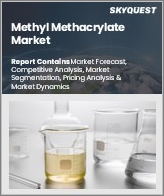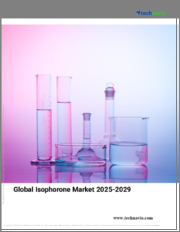
|
시장보고서
상품코드
1631214
아세톤 시장 규모, 점유율, 동향 분석 보고서 : 등급별, 용도별, 유통 채널별, 지역별, 부문별 예측(2025-2030년)Acetone Market Size, Share & Trends Analysis Report By Grade, By Application (Solvents, Methyl Methacrylate, Bisphenol A), By Distribution Channel, By Region, And Segment Forecasts, 2025 - 2030 |
||||||
아세톤 시장 성장과 동향
Grand View Research, Inc.의 최신 보고서에 따르면 아세톤 세계 시장 규모는 2025-2030년 동안 CAGR 8.1%로 성장하여 2030년에는 102억 3,000만 달러에 달할 것으로 예상됩니다. 이러한 성장의 주요 원동력은 세정제 및 플라스틱, 섬유, 화장품 및 기타 퍼스널케어 제품 생산의 용매로서 아세톤 제품의 소비가 증가하고 있기 때문입니다.
아세톤은 디메틸케톤 또는 프로판온이라는 이름으로도 불리며, 화학식(CH3)2CO로 표현되는 매우 가연성이 높은 무색의 액체입니다. 가장 작고 가장 염기성이 강한 케톤으로 가정, 기업, 실험실에서 세정용으로 자주 사용됩니다. 페놀 제조의 제품별로도 많이 사용됩니다. 와커법, 건식증류법, 쿠멘법 등이 일반적인 제조법입니다.
활성 성분인 아세톤은 우수한 용매이며, 농업에 사용되는 살균제 및 살충제의 운반체 역할을 합니다. 또한, 전 세계적으로 자기 관리와 미용에 대한 인식이 높아짐에 따라 퍼스널케어 제품에도 사용되고 있습니다. 또한, 이 제품은 세정제 및 용제로서 2액형 에폭시, 슈퍼 접착제, 폴리에스테르 수지를 제조 공정에서 고형화하기 전에 용해시키는 데 사용됩니다. 또한, 겔코트 및 폴리에스테르 수지의 세척에도 도움이 됩니다. 주조용 수지도 아세톤으로 피부에서 효과적으로 제거할 수 있습니다.
중국, 미국, 한국, 서유럽 지역이 이 제품의 주요 생산기지입니다. 아시아태평양은 제약 및 전자 산업의 급속한 성장으로 인해 이 제품에 대한 수요가 크게 증가하고 있습니다. 또한, 예측 기간 동안 가장 큰 소비 점유율을 차지했습니다. 또한, 인도는 한국, 사우디아라비아, 중국으로부터의 아세톤 수입에 반덤핑 관세를 부과하고 있기 때문에 향후 몇 년 동안 국내 생산을 늘릴 것으로 예상됩니다.
아세톤 시장 보고서 하이라이트
- 제약, 페인트, 화장품 산업에서 아세톤을 용매로 사용하는 사례가 증가함에 따라 2024년 아세톤은 33.6% 이상의 매출 점유율을 차지했습니다.
- 기술 등급 부문은 2024년 97.2%의 가장 큰 매출 점유율을 차지했으며, 예측 기간 동안에도 계속 산업을 지배할 것으로 예상됩니다.
- 북미의 아세톤 수요는 주로 용제 제조에 사용되는 아세톤에 의해 주도되고 있습니다. 미국은 자동차 제조업체의 주요 거점이며, 2022년에는 2021년 대비 4.0% 증가한 920만 대가 생산되었습니다.
목차
제1장 조사 방법과 범위
제2장 주요 요약
제3장 시장 변수, 동향, 범위
- 세계의 아세톤 시장 전망
- 밸류체인 분석
- 원료 전망
- 제조업 전망
- 가격 동향 분석
- 규제 프레임워크
- 표준과 컴플라이언스
- 시장 역학
- 시장 성장 촉진요인 분석
- 시장 성장 억제요인 분석
- 시장 과제 분석
- 시장 기회 분석
- Porter's Five Forces 분석
- 공급 기업의 교섭력
- 구매자의 교섭력
- 대체의 위협
- 신규 참여업체의 위협
- 경쟁 기업 간의 경쟁 관계
- PESTLE 분석
- 정치
- 경제
- 사회 상황
- 기술
- 환경
- 법률
제4장 아세톤 시장 : 등급별, 추정·동향 분석
- 아세톤 시장 : 등급 변동 분석, 2023년과 2030년
- 기술 등급
- 특수 등급
제5장 아세톤 시장 : 용도별, 추정·동향 분석
- 아세톤 시장 : 용도 변동 분석, 2023년과 2030년
- 용제
- 메틸 메타크릴레이트
- 비스페놀 A
- 기타
제6장 아세톤 시장 : 유통 채널별, 추정·동향 분석
- 아세톤 시장 : 등급 변동 분석, 2023년과 2030년
- 제조업체에서 판매업체로
- 제조업체에서 최종사용자로
제7장 아세톤 시장 : 지역별, 추정·동향 분석
- 지역 분석, 2023년과 2030년
- 북미
- 등급별, 2018-2030년
- 용도별, 2018-2030년
- 유통 채널별, 2018-2030년
- 미국
- 캐나다
- 멕시코
- 유럽
- 등급별, 2018-2030년
- 용도별, 2018-2030년
- 유통 채널별, 2018-2030년
- 독일
- 프랑스
- 벨기에
- CIS 국가
- 아시아태평양
- 등급별, 2018-2030년
- 용도별, 2018-2030년
- 유통 채널별, 2018-2030년
- 중국
- 인도
- 일본
- 한국
- 대만
- 라틴아메리카
- 등급별, 2018-2030년
- 용도별, 2018-2030년
- 유통 채널별, 2018-2030년
- 브라질
- 아르헨티나
- 중동 및 아프리카
- 등급별, 2018-2030년
- 용도별, 2018-2030년
- 유통 채널별, 2018-2030년
- 사우디아라비아
- 남아프리카공화국
제8장 경쟁 구도
- 주요 시장 진출 기업의 최근 동향
- 기업 분류
- 기업 히트맵 분석
- 주요 최종사용자 리스트
- 전략 매핑
- 기업 개요/상장 기업
- INEOS
- Shell plc
- Honeywell International Inc
- Mitsui Chemicals, Inc.
- CEPSA Quimica, SA
- SABIC
- Arkema
- DOMO Chemicals
- Solvay
- Kumho P&B Chemicals
Acetone Market Growth & Trends:
The global acetone market size is expected to reach USD 10.23 billion by 2030, registering a CAGR of 8.1% from 2025 to 2030, according to a new report by Grand View Research, Inc. The growth is majorly driven by the rising consumption of the product as a cleaning agent and as a solvent in the production of plastics, textiles, cosmetics, and other personal care products.
Acetone, which also goes by the names dimethyl ketone and propanone, is a highly flammable, colorless liquid with the chemical formula (CH3)2CO. It is the smallest and most basic ketone and is frequently used in homes, businesses, and laboratories for cleaning. It is frequently used as a byproduct for the production of phenol. The Wacker process, dry distillation, and the cumene process are a few popular production processes.
Acetone, for active components, is an excellent solvent and serves as a carrier agent in fungicides and insecticides, used in agriculture. Additionally, it is used in personal care products owing to the rising awareness regarding self-care and grooming across the globe. In addition, the product as a cleaning agent or solvent is used to dissolve two-part epoxies, super glue, and polyester resin before they are set in the manufacturing process. It also aids in gel coat and polyester resin cleaning. Casting resin can also be effectively removed from the skin with acetone.
China, the U.S., South Korea, and the Western European region are the main manufacturing hubs for the product. Due to the rapidly growing pharmaceutical and electronics industries, the Asia Pacific region exhibits an enormous growth in demand for the product. It is further predicted to contribute to the largest consumption share during the forecast period. In addition, India is anticipated to increase local production during the upcoming years due to the anti-dumping charges it has placed on imports of acetone from South Korea, Saudi Arabia, and China.
Acetone Market Report Highlights:
- Solvents held a revenue share of over 33.6% in 2024, owing to the increasing utilization of acetone as a solvent in pharmaceutical, paints & coatings, and cosmetics industries.
- The technical grade segment accounted for the largest revenue market share of 97.2%, in 2024 and is expected to continue to dominate the industry over the forecast period.
- The North American region's demand for acetone is primarily driven by its use in solvent manufacturing. The United States is a major hub for automotive manufacturers, producing 9.2 million vehicles in 2022, a 4.0% increase compared to 2021.
Table of Contents
Chapter 1. Methodology and Scope
- 1.1. Market Segmentation & Scope
- 1.2. Market Definition
- 1.3. Information Procurement
- 1.3.1. Information Analysis
- 1.3.2. Market Formulation & Data Visualization
- 1.3.3. Data Validation & Publishing
- 1.4. Research Scope and Assumptions
- 1.4.1. List of Data Sources
Chapter 2. Executive Summary
- 2.1. Market Snapshot
- 2.2. Segmental Outlook
- 2.3. Competitive Outlook
Chapter 3. Market Variables, Trends, and Scope
- 3.1. Global Acetone Market Outlook
- 3.2. Value Chain Analysis
- 3.2.1. Raw Material Outlook
- 3.2.2. Manufacturing Outlook
- 3.3. Price Trend Analysis
- 3.4. Regulatory Framework
- 3.4.1. Standards & Compliances
- 3.5. Market Dynamics
- 3.5.1. Market Driver Analysis
- 3.5.2. Market Restraint Analysis
- 3.5.3. Market Challenges Analysis
- 3.5.4. Market Opportunity Analysis
- 3.6. Porter's Five Forces Analysis
- 3.6.1. Bargaining Power of Suppliers
- 3.6.2. Bargaining Power of Buyers
- 3.6.3. Threat of Substitution
- 3.6.4. Threat of New Entrants
- 3.6.5. Competitive Rivalry
- 3.7. PESTLE Analysis
- 3.7.1. Political
- 3.7.2. Economic
- 3.7.3. Social Landscape
- 3.7.4. Technology
- 3.7.5. Environmental
- 3.7.6. Legal
Chapter 4. Acetone Market: Grade Estimates & Trend Analysis
- 4.1. Acetone Market: Grade Movement Analysis, 2023 & 2030
- 4.2. Technical Grade
- 4.2.1. Market estimates and forecasts, 2018 - 2030 (Kilotons) (USD Million)
- 4.3. Specialty Grade
- 4.3.1. Market estimates and forecasts, 2018 - 2030 (Kilotons) (USD Million)
Chapter 5. Acetone Market: Application Estimates & Trend Analysis
- 5.1. Acetone Market: Grade Movement Analysis, 2023 & 2030
- 5.2. Solvents
- 5.2.1. Market estimates and forecasts, 2018 - 2030 (Kilotons) (USD Million)
- 5.3. Methyl Methacrylate
- 5.3.1. Market estimates and forecasts, 2018 - 2030 (Kilotons) (USD Million)
- 5.4. Bisphenol A
- 5.4.1. Market estimates and forecasts, 2018 - 2030 (Kilotons) (USD Million)
- 5.5. Other Applications
- 5.5.1. Market estimates and forecasts, 2018 - 2030 (Kilotons) (USD Million)
Chapter 6. Acetone Market: Distribution Channel Estimates & Trend Analysis
- 6.1. Acetone Market: Grade Movement Analysis, 2023 & 2030
- 6.2. Manufacturer to Distributor
- 6.2.1. Market estimates and forecasts, 2018 - 2030 (Kilotons) (USD Million)
- 6.3. Manufacturer to End User
- 6.3.1. Market estimates and forecasts, 2018 - 2030 (Kilotons) (USD Million)
Chapter 7. Acetone Market: Regional Estimates & Trend Analysis
- 7.1. Regional Analysis, 2023 & 2030
- 7.2. North America
- 7.2.1. Market estimates and forecasts, 2018 - 2030 (Kilotons) (USD Million)
- 7.2.2. Market estimates and forecasts, by grade, 2018 - 2030 (Kilotons) (USD Million)
- 7.2.3. Market estimates and forecasts, by application, 2018 - 2030 (Kilotons) (USD Million)
- 7.2.4. Market estimates and forecasts, by distribution channel, 2018 - 2030 (Kilotons) (USD Million)
- 7.2.5. U.S.
- 7.2.5.1. Market estimates and forecasts, 2018 - 2030 (Kilotons) (USD Million)
- 7.2.5.2. Market estimates and forecasts, by grade, 2018 - 2030 (Kilotons) (USD Million)
- 7.2.5.3. Market estimates and forecasts, by application, 2018 - 2030 (Kilotons) (USD Million)
- 7.2.5.4. Market estimates and forecasts, by distribution channel, 2018 - 2030 (Kilotons) (USD Million)
- 7.2.6. Canada
- 7.2.6.1. Market estimates and forecasts, 2018 - 2030 (Kilotons) (USD Million)
- 7.2.6.2. Market estimates and forecasts, by grade, 2018 - 2030 (Kilotons) (USD Million)
- 7.2.6.3. Market estimates and forecasts, by application, 2018 - 2030 (Kilotons) (USD Million)
- 7.2.6.4. Market estimates and forecasts, by distribution channel, 2018 - 2030 (Kilotons) (USD Million)
- 7.2.7. Mexico
- 7.2.7.1. Market estimates and forecasts, 2018 - 2030 (Kilotons) (USD Million)
- 7.2.7.2. Market estimates and forecasts, by grade, 2018 - 2030 (Kilotons) (USD Million)
- 7.2.7.3. Market estimates and forecasts, by application, 2018 - 2030 (Kilotons) (USD Million)
- 7.2.7.4. Market estimates and forecasts, by distribution channel, 2018 - 2030 (Kilotons) (USD Million)
- 7.3. Europe
- 7.3.1. Market estimates and forecasts, 2018 - 2030 (Kilotons) (USD Million)
- 7.3.2. Market estimates and forecasts, by grade, 2018 - 2030 (Kilotons) (USD Million)
- 7.3.3. Market estimates and forecasts, by application, 2018 - 2030 (Kilotons) (USD Million)
- 7.3.4. Market estimates and forecasts, by distribution channel, 2018 - 2030 (Kilotons) (USD Million)
- 7.3.5. Germany
- 7.3.5.1. Market estimates and forecasts, 2018 - 2030 (Kilotons) (USD Million)
- 7.3.5.2. Market estimates and forecasts, by grade, 2018 - 2030 (Kilotons) (USD Million)
- 7.3.5.3. Market estimates and forecasts, by application, 2018 - 2030 (Kilotons) (USD Million)
- 7.3.5.4. Market estimates and forecasts, by distribution channel, 2018 - 2030 (Kilotons) (USD Million)
- 7.3.6. France
- 7.3.6.1. Market estimates and forecasts, 2018 - 2030 (Kilotons) (USD Million)
- 7.3.6.2. Market estimates and forecasts, by grade, 2018 - 2030 (Kilotons) (USD Million)
- 7.3.6.3. Market estimates and forecasts, by application, 2018 - 2030 (Kilotons) (USD Million)
- 7.3.6.4. Market estimates and forecasts, by distribution channel, 2018 - 2030 (Kilotons) (USD Million)
- 7.3.7. Belgium
- 7.3.7.1. Market estimates and forecasts, 2018 - 2030 (Kilotons) (USD Million)
- 7.3.7.2. Market estimates and forecasts, by grade, 2018 - 2030 (Kilotons) (USD Million)
- 7.3.7.3. Market estimates and forecasts, by application, 2018 - 2030 (Kilotons) (USD Million)
- 7.3.7.4. Market estimates and forecasts, by distribution channel, 2018 - 2030 (Kilotons) (USD Million)
- 7.3.8. CIS Nations
- 7.3.8.1. Market estimates and forecasts, 2018 - 2030 (Kilotons) (USD Million)
- 7.3.8.2. Market estimates and forecasts, by grade, 2018 - 2030 (Kilotons) (USD Million)
- 7.3.8.3. Market estimates and forecasts, by application, 2018 - 2030 (Kilotons) (USD Million)
- 7.3.8.4. Market estimates and forecasts, by distribution channel, 2018 - 2030 (Kilotons) (USD Million)
- 7.4. Asia Pacific
- 7.4.1. Market estimates and forecasts, 2018 - 2030 (Kilotons) (USD Million)
- 7.4.2. Market estimates and forecasts, by grade, 2018 - 2030 (Kilotons) (USD Million)
- 7.4.3. Market estimates and forecasts, by application, 2018 - 2030 (Kilotons) (USD Million)
- 7.4.4. Market estimates and forecasts, by distribution channel, 2018 - 2030 (Kilotons) (USD Million)
- 7.4.5. China
- 7.4.5.1. Market estimates and forecasts, 2018 - 2030 (Kilotons) (USD Million)
- 7.4.5.2. Market estimates and forecasts, by grade, 2018 - 2030 (Kilotons) (USD Million)
- 7.4.5.3. Market estimates and forecasts, by application, 2018 - 2030 (Kilotons) (USD Million)
- 7.4.5.4. Market estimates and forecasts, by distribution channel, 2018 - 2030 (Kilotons) (USD Million)
- 7.4.6. India
- 7.4.6.1. Market estimates and forecasts, 2018 - 2030 (Kilotons) (USD Million)
- 7.4.6.2. Market estimates and forecasts, by grade, 2018 - 2030 (Kilotons) (USD Million)
- 7.4.6.3. Market estimates and forecasts, by application, 2018 - 2030 (Kilotons) (USD Million)
- 7.4.6.4. Market estimates and forecasts, by distribution channel, 2018 - 2030 (Kilotons) (USD Million)
- 7.4.7. Japan
- 7.4.7.1. Market estimates and forecasts, 2018 - 2030 (Kilotons) (USD Million)
- 7.4.7.2. Market estimates and forecasts, by grade, 2018 - 2030 (Kilotons) (USD Million)
- 7.4.7.3. Market estimates and forecasts, by application, 2018 - 2030 (Kilotons) (USD Million)
- 7.4.7.4. Market estimates and forecasts, by distribution channel, 2018 - 2030 (Kilotons) (USD Million)
- 7.4.8. South Korea
- 7.4.8.1. Market estimates and forecasts, 2018 - 2030 (Kilotons) (USD Million)
- 7.4.8.2. Market estimates and forecasts, by grade, 2018 - 2030 (Kilotons) (USD Million)
- 7.4.8.3. Market estimates and forecasts, by application, 2018 - 2030 (Kilotons) (USD Million)
- 7.4.8.4. Market estimates and forecasts, by distribution channel, 2018 - 2030 (Kilotons) (USD Million)
- 7.4.9. Taiwan
- 7.4.9.1. Market estimates and forecasts, 2018 - 2030 (Kilotons) (USD Million)
- 7.4.9.2. Market estimates and forecasts, by grade, 2018 - 2030 (Kilotons) (USD Million)
- 7.4.9.3. Market estimates and forecasts, by application, 2018 - 2030 (Kilotons) (USD Million)
- 7.4.9.4. Market estimates and forecasts, by distribution channel, 2018 - 2030 (Kilotons) (USD Million)
- 7.5. Latin America
- 7.5.1. Market estimates and forecasts, 2018 - 2030 (Kilotons) (USD Million)
- 7.5.2. Market estimates and forecasts, by grade, 2018 - 2030 (Kilotons) (USD Million)
- 7.5.3. Market estimates and forecasts, by application, 2018 - 2030 (Kilotons) (USD Million)
- 7.5.4. Market estimates and forecasts, by distribution channel, 2018 - 2030 (Kilotons) (USD Million)
- 7.5.5. Brazil
- 7.5.5.1. Market estimates and forecasts, 2018 - 2030 (Kilotons) (USD Million)
- 7.5.5.2. Market estimates and forecasts, by grade, 2018 - 2030 (Kilotons) (USD Million)
- 7.5.5.3. Market estimates and forecasts, by application, 2018 - 2030 (Kilotons) (USD Million)
- 7.5.5.4. Market estimates and forecasts, by distribution channel, 2018 - 2030 (Kilotons) (USD Million)
- 7.5.6. Argentina
- 7.5.6.1. Market estimates and forecasts, 2018 - 2030 (Kilotons) (USD Million)
- 7.5.6.2. Market estimates and forecasts, by grade, 2018 - 2030 (Kilotons) (USD Million)
- 7.5.6.3. Market estimates and forecasts, by application, 2018 - 2030 (Kilotons) (USD Million)
- 7.5.6.4. Market estimates and forecasts, by distribution channel, 2018 - 2030 (Kilotons) (USD Million)
- 7.6. Middle East & Africa
- 7.6.1. Market estimates and forecasts, 2018 - 2030 (Kilotons) (USD Million)
- 7.6.2. Market estimates and forecasts, by grade, 2018 - 2030 (Kilotons) (USD Million)
- 7.6.3. Market estimates and forecasts, by application, 2018 - 2030 (Kilotons) (USD Million)
- 7.6.4. Market estimates and forecasts, by distribution channel, 2018 - 2030 (Kilotons) (USD Million)
- 7.6.5. Saudi Arabia
- 7.6.5.1. Market estimates and forecasts, 2018 - 2030 (Kilotons) (USD Million)
- 7.6.5.2. Market estimates and forecasts, by grade, 2018 - 2030 (Kilotons) (USD Million)
- 7.6.5.3. Market estimates and forecasts, by application, 2018 - 2030 (Kilotons) (USD Million)
- 7.6.5.4. Market estimates and forecasts, by distribution channel, 2018 - 2030 (Kilotons) (USD Million)
- 7.6.6. South Africa
- 7.6.6.1. Market estimates and forecasts, 2018 - 2030 (Kilotons) (USD Million)
- 7.6.6.2. Market estimates and forecasts, by grade, 2018 - 2030 (Kilotons) (USD Million)
- 7.6.6.3. Market estimates and forecasts, by application, 2018 - 2030 (Kilotons) (USD Million)
- 7.6.6.4. Market estimates and forecasts, by distribution channel, 2018 - 2030 (Kilotons) (USD Million)
Chapter 8. Competitive Landscape
- 8.1. Recent Developments By Key Market Participants
- 8.2. Company Categorization
- 8.3. Company Heat Map Analysis
- 8.4. List of Key End Users
- 8.5. Strategy Mapping
- 8.6. Company Profiles/Listing
- 8.6.1. INEOS
- 8.6.1.1. Company Overview
- 8.6.1.2. Financial Performance
- 8.6.1.3. Grade Benchmarking
- 8.6.2. Shell plc
- 8.6.2.1. Company Overview
- 8.6.2.2. Financial Performance
- 8.6.2.3. Grade Benchmarking
- 8.6.3. Honeywell International Inc
- 8.6.3.1. Company Overview
- 8.6.3.2. Financial Performance
- 8.6.3.3. Grade Benchmarking
- 8.6.4. Mitsui Chemicals, Inc.
- 8.6.4.1. Company Overview
- 8.6.4.2. Financial Performance
- 8.6.4.3. Grade Benchmarking
- 8.6.5. CEPSA Quimica, S.A.
- 8.6.5.1. Company Overview
- 8.6.5.2. Financial Performance
- 8.6.5.3. Grade Benchmarking
- 8.6.6. SABIC
- 8.6.6.1. Company Overview
- 8.6.6.2. Financial Performance
- 8.6.6.3. Grade Benchmarking
- 8.6.7. Arkema
- 8.6.7.1. Company Overview
- 8.6.7.2. Financial Performance
- 8.6.7.3. Grade Benchmarking
- 8.6.8. DOMO Chemicals
- 8.6.8.1. Company Overview
- 8.6.8.2. Financial Performance
- 8.6.8.3. Grade Benchmarking
- 8.6.9. Solvay
- 8.6.9.1. Company Overview
- 8.6.9.2. Financial Performance
- 8.6.9.3. Grade Benchmarking
- 8.6.10. Kumho P&B Chemicals
- 8.6.10.1. Company Overview
- 8.6.10.2. Financial Performance
- 8.6.10.3. Grade Benchmarking
- 8.6.1. INEOS
(주말 및 공휴일 제외)


















